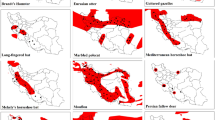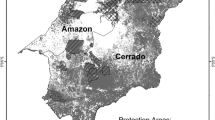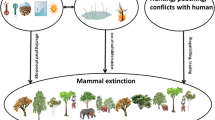Abstract
Climate change is not only a major threat to biodiversity, it is also a big challenge to the development of conservation strategies. Scientists and practitioners need to select or avoid areas at greatest risk for species protection, i.e., acting in a proactive or a reactive manner. This proactive/reactive dichotomy takes a particular formulation under the likely changes in climate. Selecting for low-risk areas (usually referred to as climate refugia) is supposed to protect more species with a greater guarantee of their long-term persistence. As a consequence, populations at greatest risk are left unprotected and probably committed to extinction. On the other hand, managing species in high-risk areas is more expensive than setting aside areas of climate refugia and encompasses a set of uncertainties, which makes highly-threatened species more costly and difficult to save. Here, we combine ecological niche models and metrics of climate change to develop spatial conservation schemes for mammals in the Brazilian Amazon. These schemes efficiently identify networks of high-risk and refugia priority areas within species current and future distributions, while complementing the protection already achieved by the Amazon’s network of protected areas (PAs). We found that, on average, 25% of mammal distribution is already represented in the established network of PAs. Also, 26% of high-risk and 17% of refugia priority areas overlap with indigenous lands. In addition, species distributions were found mostly in high-risk, compared to in refugia priority areas. We highlight that the strategy to be employed does not necessarily should be binary and a mix of both strategies would guarantee the protection of a larger number of species.





Similar content being viewed by others
References
Allouche O, Tsoar A, Kadmon R (2006) Assessing the accuracy of species distribution models: prevalence, kappa and the true skill statistic (TSS). J Appl Ecol 43:1223–1232
Ameca y Juárez EI, Mace GM, Cowlishaw G, Pettorelli N (2012) Natural population die-offs: causes and consequences for terrestrial mammals. Trends Ecol Evol 27:272–277
Ameca y Juárez EI, Mace GM, Cowlishaw G, Cornforth WA, Pettorelli N (2013) Assessing exposure to extreme climatic events for terrestrial mammals. Conserv Lett 6:145–153
Araújo MB, New M (2007) Ensemble forecasting of species distributions. Trends Ecol Evol 22:42–47
Araujo MB, Cabeza M, Thuiller W, Hannah L, Williams PH (2004) Would climate change drive species out of reserves? An assessment of existing reserve-selection methods. Glob Change Biol 10:1618–1626
Ashcroft MB, Gollan JR, Warton DI, Ramp D (2012) A novel approach to quantify and locate potential microrefugia using topoclimate, climate stability, and isolation from the matrix. Glob Change Biol 18:1866–1879
Beaumont LJ, Pitman A, Perkins S, Zimmermann NE, Yoccoz NG (2011) Impacts of climate change on the world’s most exceptional ecoregions. Proc Natl Acad Sci USA 108:2306–2311
Boon PY, Beger M (2016) The effect of contrasting threat mitigation objectives on spatial conservation priorities. Mar Policy 68:23–29
Bottrill MC, Joseph LN, Carwardine J, Bode M, Cook C, Game ET, Grantham H, Kark S, Linke S, McDonald-Madden E, Pressey RL, Walker S, Wilson KA, Possingham HP (2008) Is conservation triage just smart decision making? Trends Ecol Evol 23:649–654
Brando PM, Balch JK, Nepstad DC, Morton DC, Putz FE, Coe MT, Silverio D, Macedo MN, Davidson EA, Nobrega CC, Alencar A, Soares-Filho BS (2014) Abrupt increases in Amazonian tree mortality due to drought–fire interactions. Proc Natl Acad Sci USA 111:6347–6352
Brooks TM, Mittermeier RA, da Fonseca GAB, Gerlach J, Hoffmann M, Lamoreux JF, Mittermeier CG, Pilgrim JD, Rodrigues ASL (2006) Global biodiversity conservation priorities. Science 313:58–61
Carroll C, Dunk JR, Moilanen A (2010) Optimizing resiliency of reserve networks to climate change: multispecies conservation planning in the Pacific Northwest, USA. Glob Change Biol 16:891–904
Cruz-McDonnell KK, Wolf BO (2016) Rapid warming and drought negatively impact population size and reproductive dynamics of an avian predator in the arid southwest. Glob Change Biol 22:237–253
Deutsch CA, Tewksbury JJ, Huey RB, Sheldon KS, Ghalambor CK, Haak DC, Martin PR (2008) Impacts of climate warming on terrestrial ectotherms across latitude. Proc Natl Acad Sci USA 105:6668–6672
Diffenbaugh NS, Field CB (2013) Changes in ecologically critical terrestrial climate conditions. Science 341:486–492
Diniz-Filho JAF, Mauricio Bini L, Fernando Rangel T, Loyola RD, Hof C, Nogués-Bravo D, Araújo MB (2009) Partitioning and mapping uncertainties in ensembles of forecasts of species turnover under climate change. Ecography 32:897–906
Elith J, Graham CH, Anderson RP, Dudík M, Ferrier S, Guisan A, Hijmans RJ, Huettmann F, Leathwick JR, Lehmann A, Li J, Lohmann LG, Loiselle BA, Manion G, Moritz C, Nakamura M, Nakazawa Y, Overton JMcCM, Townsend Peterson A, Phillips SJ, Richardson K, Scachetti-Pereira R, Schapire RE, Soberón J, Williams S, Wisz MS, Zimmermann NE (2006) Novel methods improve prediction of species’ distributions from occurrence data. Ecography 29:129–151
Elith J, Kearney M, Phillips S (2010) The art of modelling range-shifting species. Methods Ecol Evol 1:330–342
Foden WB, Butchart SHM, Stuart SN, Vié JC, Akçakaya HR, Angulo A, DeVantier LM, Gutsche A, Turak E, Cao L, Donner SD, Katariya V, Bernard R, Holland RA, Hughes AF, O’Hanlon SE, Garnett ST, Şekercioğlu ÇH, Mace GM (2013) Identifying the world’s most climate change vulnerable species: a systematic trait-based assessment of all birds, amphibians and corals. PLoS ONE 8:e65427
Game ET, Lipsett-Moore G, Saxon E, Peterson N, Sheppard S (2011) Incorporating climate change adaptation into national conservation assessments. Glob Change Biol 17:3150–3160
Garcia RA, Cabeza M, Rahbek C, Araújo MB (2014) Multiple dimensions of climate change and their implications for biodiversity. Science 344:1247579
Gloor M, Barichivich J, Ziv G, Brienen R, Schöngart J, Peylin P, Ladvocat Cintra BB, Feldpausch T, Phillips O, Baker J (2015) Recent Amazon climate as background for possible ongoing and future changes of Amazon humid forests. Glob Biogeochem Cycles 29:1384–1399
Hamann A, Roberts DR, Barber QE, Carroll C, Nielsen SE (2015) Velocity of climate change algorithms for guiding conservation and management. Glob Change Biol 21:997–1004
Heller NE, Zavaleta ES (2009) Biodiversity management in the face of climate change: a review of 22 years of recommendations. Biol Conserv 142:14–32
Huey RB, Kearney MR, Krockenberger A, Holtum JAM, Jess M, Williams SE (2012) Predicting organismal vulnerability to climate warming: roles of behaviour, physiology and adaptation. Philos Trans R Soc B 367:1665–1679
IPCC (2013) Climate change 2013: the physical science basis. Contribution of Working Group I to the Fifth Assessment Report of the Intergovernmental Panel on Climate Change. Intergovernmental Panel on Climate Change, Working Group I Contribution to the IPCC Fifth Assessment Report (AR5). Cambridge University Press, New York, 1535
IPCC (2014a) Climate change 2014: synthesis report. Contribution of Working Groups I, II and III to the Fifth Assessment Report of the Intergovernmental Panel on Climate Change
IPCC (2014b) Summary for policy makers. Climate change 2014: impacts, adaptation and vulnerability—contributions of the Working Group II to the Fifth Assessment Report, p 1–32
IPCC, Field CB, Barros V, Stocker TF, Qin D, Dokken DJ, Ebi KL, Mastrandrea MD, Mach KJ, Plattner G-K, Allen SK, Tignor M, Midgley PM (2012) Managing the risks of extreme events and disasters to advance climate change adaptation—SREX summary for policymakers
Jachowski DS, Kesler DC (2009) Allowing extinction: should we let species go? Trends Ecol Evol 24:180
Katz RW, Brush GS, Parlange MB (2005) Statistics of extremes: modeling ecological disturbances. Ecology 86:1124–1134
Khaliq I, Hof C, Prinzinger R, Böhning-Gaese K, Pfenninger M (2014) Global variation in thermal tolerances and vulnerability of endotherms to climate change. Proc Biol Sci R Soc 281:20141097
Killeen TJ, Solórzano LA (2008) Conservation strategies to mitigate impacts from climate change in Amazonia. Philos Trans R Soc Lond B 363:1881–1888
Kingsolver JG, Diamond SE, Buckley LB (2013) Heat stress and the fitness consequences of climate change for terrestrial ectotherms. Funct Ecol 27:1415–1423
Knight AT, Cowling RM, Campbell BM (2006) An operational model for implementing conservation action. Conserv Biol 20:408–419
Ladle R, Whittaker R (eds) (2011) Conservation biogeography. Wiley-Blackwell, Oxford
Lemes P, Loyola RD (2013) Accommodating species climate-forced dispersal and uncertainties in spatial conservation planning. PLoS ONE 8:e54323
Lemes P, Melo AS, Loyola RD (2013) Climate change threatens protected areas of the Atlantic Forest. Biodivers Conserv 23:357–368
Li Y, Li X, Sandel B, Blank D, Liu Z, Liu X, Yan S (2015) Climate and topography explain range sizes of terrestrial vertebrates. Nat Clim Change. https://doi.org/10.1038/nclimate2895
Liu C, Berry PM, Dawson TP, Pearson RG (2005) Selecting thresholds of occurrence in the prediction of species distributions. Ecography 28:385–393
Loarie SR, Duffy PB, Hamilton H, Asner GP, Field CB, Ackerly DD (2009) The velocity of climate change. Nature 462:1052–1055
Lovejoy TE (2006) Protected areas: a prism for a changing world. Trends Ecol Evol 21:329–333
Loyola RD, de Oliveira G, Diniz-Filho JAF, Lewinsohn TM (2008) Conservation of Neotropical carnivores under different prioritization scenarios: mapping species traits to minimize conservation conflicts. Divers Distrib 14:949–960
Loyola RD, Lemes P, Faleiro FV, Trindade-Filho J, Machado RB (2012) Severe loss of suitable climatic conditions for marsupial species in Brazil: challenges and opportunities for conservation. PLoS ONE 7:e46257
Loyola RD, Lemes P, Nabout JC, Trindade-Filho J, Sagnori MD, Dobrovolski R, Diniz-Filho JAF (2013) A straightforward conceptual approach for evaluating spatial conservation priorities under climate change. Biodivers Conserv 22:483–495
Loyola R, Machado N, Vila-Nova DA, Martins E, Martinelli G (2014) Áreas prioritárias para conservação e uso sustentável da flora brasileira ameaçada de extinção. Andrea Jakobsson Estúdio: Instituto de Pesquisas Jardim Botânico, Rio de Janeiro
Luterbacher J (2004) European seasonal and annual temperature variability, trends, and extremes since 1500. Science 303:1499–1503
Malhi Y, Roberts JT, Betts RA, Killeen TJ, Li W, Nobre CA (2008) Climate change, deforestation, and the fate of the Amazon. Science 319:169–172
Margules CR, Pressey RL (2000) Systematic conservation planning. Nature 405:243–253
Moilanen A, Franco AMA, Early RI, Fox R, Wintle B, Thomas CD (2005) Prioritizing multiple-use landscapes for conservation: methods for large multi-species planning problems. Proc R Soc Biol Sci 272:1885–1891
Moilanen A, Veach V, Meller L, Arponen A, Kujala H (2014) Zonation—spatial conservation planning methods and software. Version 4. User manual
Morelli TL, Daly C, Dobrowski SZ, Dulen DM, Ebersole JL, Jackson ST, Lundquist JD, Millar CI, Maher SP, Monahan WB, Nydick KR, Redmond KT, Sawyer SC, Stock S, Beissinger SR (2016) Managing climate change refugia for climate adaptation. PLoS ONE 11:e0159909
Nepstad D, Schwartzman S, Bamberger B, Santilli M, Ray D, Schlesinger P, Lefebvre P, Alencar A, Prinz E, Fiske G, Rolla A (2006) Inhibition of Amazon deforestation and fire by parks and indigenous lands. Conserv Biol J Soc Conserv Biol 20:65–73
Pacheco P (2009) Agrarian reform in the Brazilian Amazon: its implications for land distribution and deforestation. World Dev 37:1337–1347
Paglia AP, da Fonseca GAB, Rylands AB, Herrmann G, Aguiar LMS, Chiarello AG, Leite YLR, Costa LP, Siciliano S, Kierulff MCM, Mendes SL, da Tavares VC, Mittermeier RA, Patton JL (2012) Lista Anotada dos Mamíferos do Brasil 2a Edição
Parmesan C (2006) Ecological and evolutionary responses to recent climate change. Annu Rev Ecol Evol Syst 37:637–669
Parmesan C, Yohe G (2003) A globally coherent fingerprint of climate change impacts across natural systems. Nature 421:37–42
Pereira HM, Leadley PW, Proença V, Alkemade R, Scharlemann JPW, Fernandez-Manjarrés JF, Araújo MB, Balvanera P, Biggs R, Cheung WWL, Chini L, Cooper HD, Gilman EL, Guénette S, Hurtt GC, Huntington HP, Mace GM, Oberdorff T, Revenga C, Rodrigues P, Scholes RJ, Sumaila UR, Walpole M (2010) Scenarios for global biodiversity in the 21st century. Science 330:1496–1501
Peres CA (1991) Humboldt’s woolly monkeys decimated by hunting in Amazonia. Oryx 25:89–95
Peters GP, Marland G, Le Quéré C, Boden T, Canadell JG, Raupach MR (2011) Rapid growth in CO2 emissions after the 2008–2009 global financial crisis. Nat Clim Change 2:2–4
Phillips SJ, Anderson RP, Schapire RE (2006) Maximum entropy modeling of species geographic distributions. Ecol Model 190:231–259
Pressey RL, Visconti P, Ferraro PJ (2015) Making parks make a difference: poor alignment of policy, planning and management with protected-area impact, and ways forward. Philos Trans R Soc Lond B 370:20140280
R Core Team (2015) R: A language and environment for statistical computing. In: R Foundation for Statistical Computing, Vienna, Austria. https://www.r-project.org/
Rayfield B, Moilanen A, Fortin M-J (2009) Incorporating consumer–resource spatial interactions in reserve design. Ecol Model 220:725–733
Ribeiro BR, Sales LP, De Marco P, Loyola R (2016) Assessing mammal exposure to climate change in the Brazilian Amazon. PLoS ONE 11:e0165073
Schmitz OJ, Lawler JJ, Beier P, Groves C, Knight G, Douglas ABJ, Bullock J, Johnston KM, Klein ML, Muller K, Pierce DJ, Singleton WR, Strittholt JR, Theobald DM, Trombulak SC, Trainor A (2015) Conserving biodiversity: practical guidance about climate change adaptation approaches in support of land-use planning. Nat Areas J 35:190–203
Sinervo B, Mendez-de-la-Cruz F, Miles DB, Heulin B, Bastiaans E, Villagran-Santa Cruz M, Lara-Resendiz R, Martinez-Mendez N, Calderon-Espinosa ML, Meza-Lazaro RN, Gadsden H, Avila LJ, Morando M, De la Riva IJ, Sepulveda PV, Rocha CFD, Ibarguengoytia N, Puntriano CA, Massot M, Lepetz V, Oksanen TA, Chapple DG, Bauer AM, Branch WR, Clobert J, Sites JW (2010) Erosion of lizard diversity by climate change and altered thermal niches. Science 328:894–899
Sunday JM, Bates AE, Kearney MR, Colwell RK, Dulvy NK, Longino JT, Huey RB (2014) Thermal-safety margins and the necessity of thermoregulatory behavior across latitude and elevation. Proc Natl Acad Sci USA 111:5610–5615
Terribile LC, Lima-Ribeiro MS, Araújo MB, Bizão N, Collevatti RG, Dobrovolski R, Franco AA, Guilhaumon F, Lima JDS, Murakami DM, Nabout JC, De Oliveira G, De Oliveira LK, Rabelo SG, Pires M, Telles DC, Diniz-Filho JAF (2012) Areas of climate stability of species ranges in the Brazilian Cerrado: disentangling uncertainties through time. Nat Conserv 10:152–159
Thuiller W, Lafourcade B, Engler R, Araújo MB (2009) BIOMOD – a platform for ensemble forecasting of species distributions. Ecography 32:369–373
Veríssimo A, Rolla A, Vedoveto M, Futada SDM (2011) Protected areas in the Brazilian Amazon: challenges and opportunities. http://hdl.handle.net/11465/1216
Vilela B, Villalobos F (2015) letsR: a new R package for data handling and analysis in macroecology. Methods Ecol Evol 6:1229–1234
Walther G-R (2010) Community and ecosystem responses to recent climate change. Philos Trans R Soc Lond B 365:2019–2024
Watson JEM, Iwamura T, Butt N (2013) Mapping vulnerability and conservation adaptation strategies under climate change. Nat Clim Change 3:989–994
Williams JW, Jackson ST, Kutzbach JE (2007) Projected distributions of novel and disappearing climates by 2100 AD. Proc Natl Acad Sci USA 104:5738–5742
Wisz MS, Hijmans RJ, Li J, Peterson AT, Graham CH, Guisan A (2008) Effects of sample size on the performance of species distribution models. Divers Distrib 14:763–773
Acknowledgements
We thank Fernanda Brum, Paulo De Marco Júnior and Nathália Machado, Javaria Altaf and three anonymous reviewers for comments that greatly improved the quality of this manuscript. We also thank Geiziane Tessarolo for help with ENMs and Raquel Garcia for providing the scripts of climate change metrics. B.R.R. and L.P.S were supported by CNPq and CAPES Scholarships, respectively. RL research is funded by CNPq (Grant 308532/2014-7), O Boticário Group Foundation for Nature Protection (Grant PROG_0008_2013), and CNCFlora (Grant 065/2016). This paper is a contribution of the Brazilian Network on Global Climate Change Research funded by CNPq (Grant 437167/2016-0) and FINEP (Grant 01.13.0353.00) and of the INCT in Ecology, Evolution and Biodiversity Conservation founded by MCTIC/CNPq/FAPEG (Grant 465610/2014-5).
Author information
Authors and Affiliations
Corresponding author
Additional information
Communicated by David Hawksworth.
Electronic supplementary material
Below is the link to the electronic supplementary material.
Rights and permissions
About this article
Cite this article
Ribeiro, B.R., Sales, L.P. & Loyola, R. Strategies for mammal conservation under climate change in the Amazon. Biodivers Conserv 27, 1943–1959 (2018). https://doi.org/10.1007/s10531-018-1518-x
Received:
Revised:
Accepted:
Published:
Issue Date:
DOI: https://doi.org/10.1007/s10531-018-1518-x




